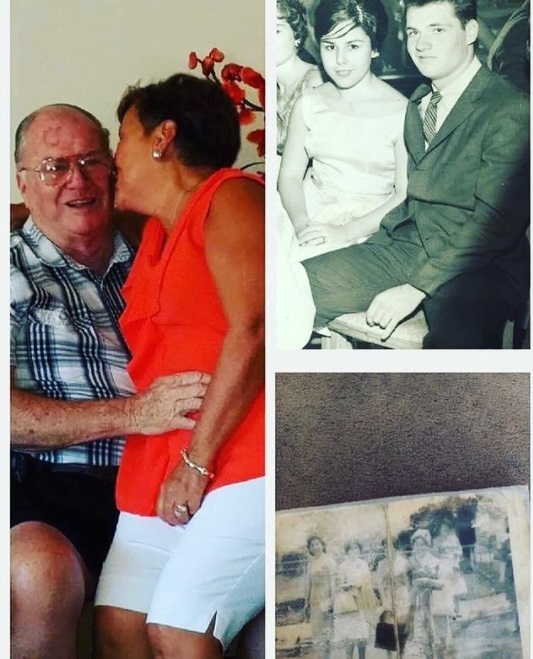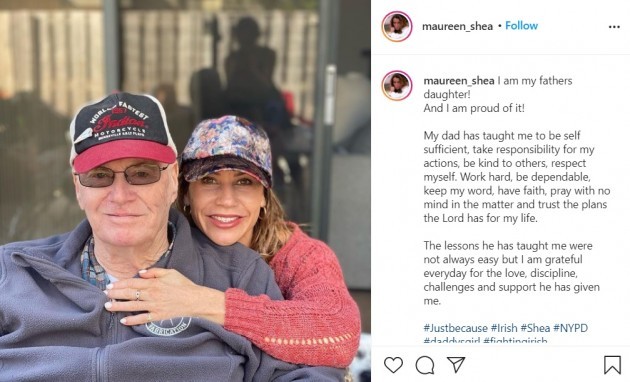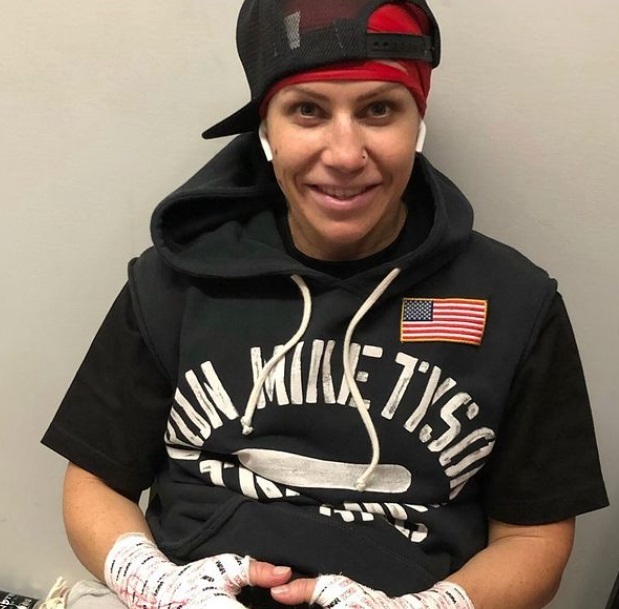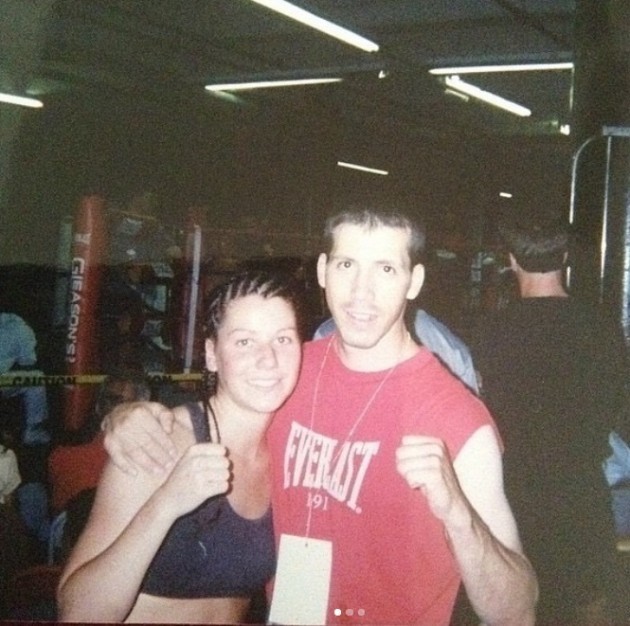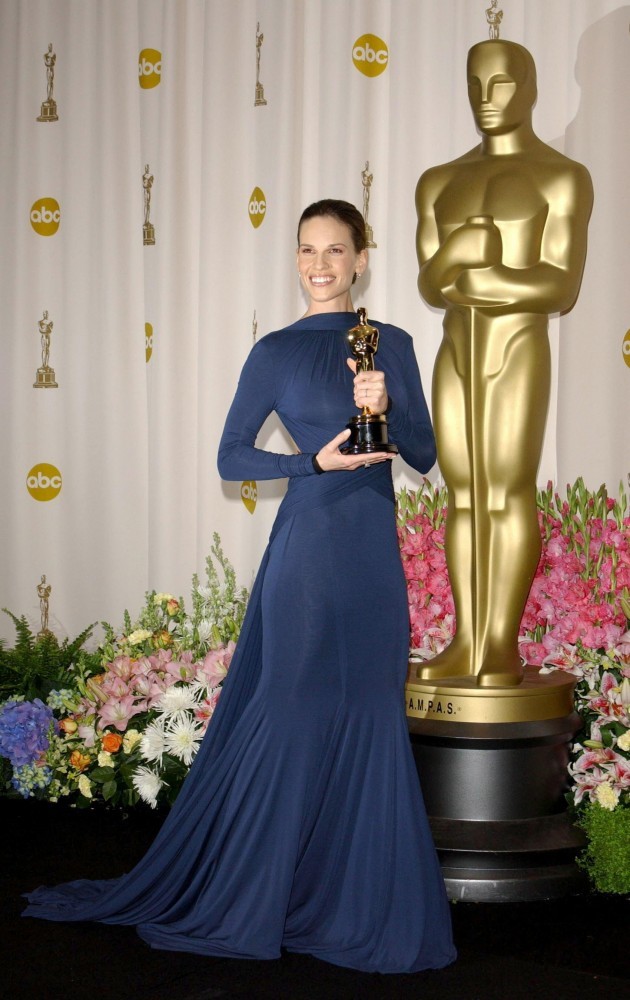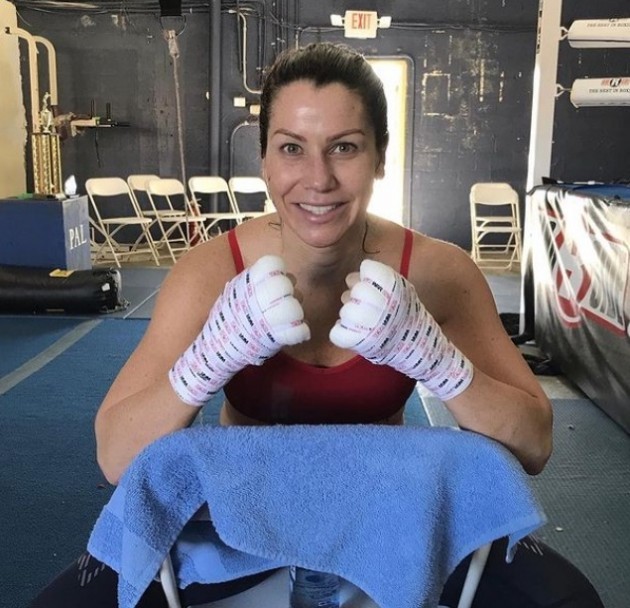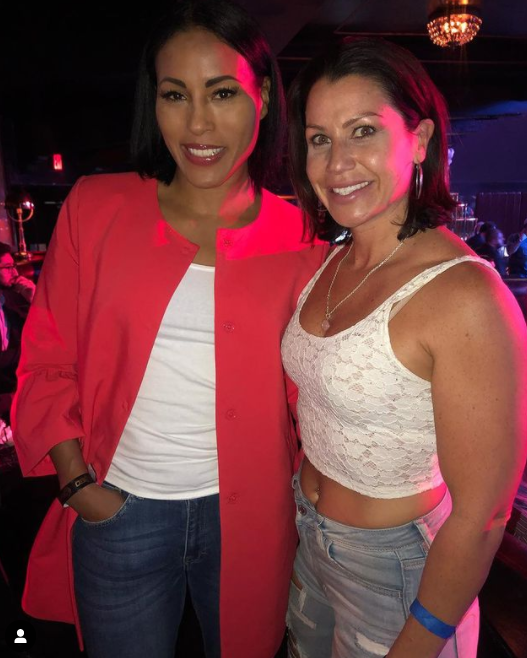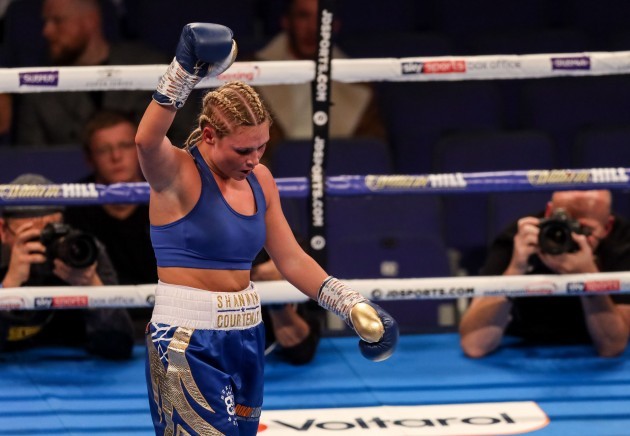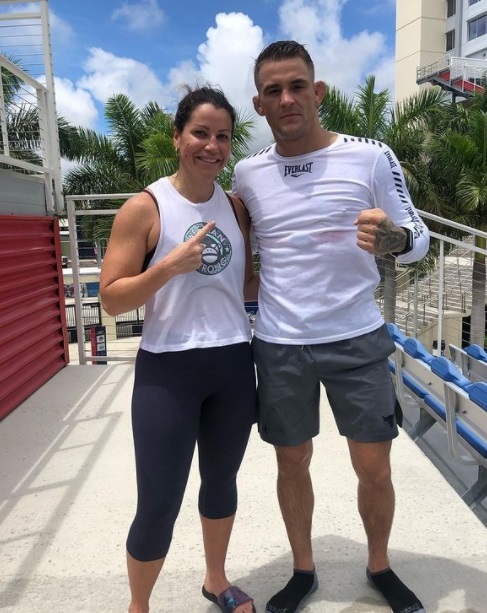MAUREEN SHEA HAS been a fighter all her life and a boxer for more than half of it. With her dual heritage, she might have been born to do both.
Shea’s father, third-generation Irish, was reared in The Bronx. Her mother, second-generation Mexican, was raised in Queens.
They met after her father, aged 18, hit his head quite heavily while working on a car and, as he regained his senses, called across the street to his friend Fran inquiring if she had ‘any pictures of some pretty girls’ to take the edge off. Fran produced a group photo of her peers which contained, among others, Maureen’s mother and her mother’s identical twin. Her father pointed at her mother specifically and said, ‘I want to meet her. I want her to be my wife.’
They dated for seven years until the local priest at St Benedict’s Church in The Bronx opened his book, pointed at a date and told them, ‘This is when you’re getting married.’
They remained so for 54 years until Shea’s father passed away just a few weeks ago, over Easter. He had carried Fran’s photo in his wallet since 1961.
Shea’s Irish roots predominantly wind through Kerry, but stray into Cork and even as far as Dublin.
“But what’s funny”, she says, “is that my closest friends who I met in grammar school, the Lawtons — they’re actually from Cork. I immediately just felt this connection with them.
“I call potatoes ‘spuds’, their father would call me ‘an eejit’ when we were growing up,” she laughs. “I’ve gotten to experience the real culture through the Lawtons, and I love that. I’ve even had pudding!”
Shea speaks English with a New York-Irish accent but equally speaks fluent Spanish with a Mexican twang. Growing up, the latter used to evoke double-takes from Dominican and Puerto Rican passers-by in The Bronx — partly because their borough is not traditionally a Mexican stronghold, but more so because Shea was a freckly red-headed lass.
But that’s not why Mr Lawton used to call her an eejit.
“I was like the wild child,” she says. “It was like, ‘Maureen can’t pay attention or sit still for one minute.’ I had a lot of uncontrolled rage. And being raised by an old Irish Catholic father who’s a cop — he was an NYPD detective — is not easy. He didn’t treat me like a girl or a boy — he treated me like a person. If I did something, I paid the repercussions, just as my brother would have. ‘You reap what you sow.’ He always told me that I marched to the beat of my own drum; I did what I wanted but I had to learn things the hard way. And I did.
“My brother is 10 years older than me so I was raised a little bit more old-school than my friends. It was tough: ‘Do what you’re told when you’re told, speak when you’re spoken to.’ And here I am, this ball of energy with impulsive speech. I was extremely reactive. And I paid for that. If I missed curfew, I’d be locked out of the house. If I acted out: ‘Spank her, lock her in her room.’ ‘You want to curse? Okay, you’re going to get whipped.’
Shea would get in the odd scrape, sure, but she spent years fighting a lot of things unbeknownst to herself. Chemicals. Compulsions. Feelings.
She tried to channel it all into sport. Softball was too soft. Basketball the same. Tennis was okay but wouldn’t suffice.
“I think I took to boxing”, she says, “because not only is it physical, but it’s quite emotional. And there was one emotion I needed to understand, which was my anger.
“I had been going to therapy since I was seven. They tried diagnosing me with bipolar disorder when I was 14 years old. I have bipolar in my family, they heard that, and right away… They put me on lithium! At 14. And then they put me on Depakote. Then Prozac…”
She continues to reel off a plethora of medications that have been prescribed to her throughout her life, “All because of my ‘mood’, y’know? And I didn’t understand it when I was young — nobody did. But I was angry because I was misunderstood.”
***
He instilled in her many positive values that became definitive parts of her character but Shea describes her father as having been, “for lack of better words, emotionally unavailable” until his final years.
“He knew it,” she says. “We’ve talked about it. Even when he was ill and he knew it was his time, he just kept telling me how beautiful I am, how much he loved me. He didn’t do that much when I was a kid. And do I wish I had that as a kid? Yeah, I do. But I learned that he did love me.
“I ended up in the abusive relationship because I became attracted to emotionally unavailable men. I’m not blaming my father at all,” she stresses. “He never hit my mother, he was not abusive towards her at all. But it makes sense.”
It began in her late teens, around the turn of the millennium.
“My ex was my best friend. He had actually pursued me to be in a relationship for about a year but I kept saying, ‘Nope, nope, nope’, because he was the ‘muscle guy’ in the neighbourhood; he was a good-looking guy but he had a bad reputation.
“I struggled for self-esteem. I never looked at myself as pretty. I never thought about looks; I was a tomboy. But he was charming. He did all the right things, bought me flowers, wrote me a letter, and finally I was like, ‘Okay, okay. I’ll be your girlfriend.’
“And it was great for the first six months. And then he started to become verbally abusive. ‘Bitch.’ ‘You’re acting like a whore.’ He started breaking me down that way. And then it became physical, he started to react to things.
“I didn’t know what to do. I think there was part fear, part confusion, but part excitement. And I just stayed — because you do get addicted to chaos. I think it became like an addiction.
“But this was when I knew I was really in it: everyone in the neighbourhood told me he was doing steroids and I didn’t believe it. I was saying, ‘He’s in the gym four hours a day, there’s no way.’ And I remember he asked me to go out and get something out of his bag in the trunk of his car, and I found the vial and the needle. I went in and said, ‘I don’t know what this is but it’s illegal. Take me home, I don’t want to be a part of this.’
He was driving me home and he was talking to me and I just kept looking out the window, ignoring him. He got mad, he pulled over, he grabbed me by my throat and started to strangle me. He held my head between the car seats and he was saying, ‘Die.’ And I remember I was losing oxygen to my brain. I kept seeing colours. And I was just like, ‘Oh my God, I’m dying.’ I said, ‘God, if it’s my time, take me.’ I passed out.
“When I came to, I had fallen out of the car and he was gone. People were walking towards me and I just remember getting up and running home. I was like three blocks from my house and when I got home, he was sitting on my steps crying. And what did I do? I went, ‘No, I’m okay,’ and he hugged me.
“I think he had an anger that I connected with at that time because I felt it too, but I never inflicted pain on somebody else. I had a compassion, like, ‘No, no, no, you’re not this person. I get it.’
“Another time, we were getting out of the car and I pulled him by his shirt and I said, ‘I’m not done talking to you,’ and he turned around and punched me in my face. I had eight stitches above my eyebrow.”
She had not yet laced up a pair of boxing gloves at that juncture but it remains the only time in her life in which Shea has ever required stitches.
“And you know what? I felt I deserved it,” she says, “That’s the weird thing.
“I’m sitting there, I can feel the blood trickling down my eye and I’m thinking: ‘You deserve this. You’re shit. You’re broken. You need to fix this and he’ll be better.’
“I hid it from everybody. I hid it from my parents. I had eight stitches and I made up a story that I got hit by a softball while I had sunglasses on. Oh, I was great with the stories. I defended him.
“I’d almost look at my own ‘faults’”, she adds, “to make what he was doing okay.
It took me until I was 26 years old to put a restraining order on him — I was with him since I was 17, 18. I turned pro in that time and there was still a sense of, ‘I don’t want to hurt him, I’ve gotta protect him.’
Now 40, Shea hosts events at which she speaks with domestic violence victims. To be able to do so has taken years of therapy, research, and “almost PTSD-like” experiences as she sought answers and found most of them.
The hardest part of speaking with victims, she says, is that “most of them are still in it, and you have to try and convince them that they don’t deserve it.
“But I realise that I can’t convince them,” she adds. “I can only let them connect to the vulnerable me, and then let them see who I am now.”
In many cases, both women and men bring to her events friends whom they feel they are unable to help themselves. Though the victims themselves are mostly women, Shea stresses that domestic violence is “not gender-specific, not culturally specific, not economically specific.”
After the relationship, Shea became a compulsive eater, a self-saboteur; she struggled with depression and anorexia.
She draws a comparison between the psychological impact of domestic violence and TV adverts for medication in which “the side effects are this, this, this, this, and this…and probably death.”
Shea has planned to take her own life on three separate occasions. She credits her faith in God, instilled by an Irish Catholic father and a Mexican Catholic mother, as being a significant factor in why she’s here to acknowledge as much.
“I almost drove my car off a highway but I knew enough to stop and call my mom and come get me. And I’m like, ‘You (God) must really want me here, you must really want me to do something.’”
And yet, during her 20s, life for Shea was often kind of purgatorial. “I didn’t want to die but I didn’t want to live, either,” she says. “I’d describe it as like living in a fishbowl. I saw everybody living and I was like, ‘I can’t.’
“I knew that there was life out there and that I could live it, but I didn’t know how to. I knew that I was loved, but I couldn’t feel it. ‘How come I can’t feel it?’
***
You’ll struggle to find a better connected boxer in the global sport than Maureen Shea. Her friendships span generations of the sport.
She’s close to Roberto Duran’s daughter and once watched his fights against Sugar Ray Leonard alongside the great ‘Hands of Stone’ down in his native Panama.
She’s the only woman to have trained with Vasyl Lomachenko and his father-coach at their ‘boxing laboratory’ in Oxnard, California.
She’s the part-owner of a tequila company — One With Life — at which her business partners are International Boxing Hall of Famers Larry Holmes and Ray ‘Boom Boom’ Mancini, current undisputed lightweight champion Teofimo Lopez, and former New York promoter Lisa Elovich. ‘Boom Boom’ once co-commentated on one of Shea’s pro fights during which he expressed an intolerance for women’s boxing. On a recent business Zoom call, Shea jokingly pulled him up on his comments and he was quick to remind her, ‘I did say you could fight, though!’
But her connection to boxing itself stems back to a friend’s house when she was 15 or 16. “I’d never seen it in my life,” she says. “We were hanging around in the kitchen, my friend’s father was having a party and they were in the living room watching TV. All of a sudden, there’s uproar in the living room. We run in. I’m sitting on a futon watching the TV. And Mike Tyson has bitten Evander Holyfield’s ear.
“I had no idea who either guy was but I was like…” Shea acts out the scene, hands cupped around her dropped jaw.
I connected with Mike Tyson. I felt the rage. Now, did I want to bite somebody’s ear? No. But I’m like… ‘I GET IT! I get that!’ I couldn’t say it when I was 15 years old or I’d sound like a crazy person but I connected with it on an emotional level. I was fascinated by Mike Tyson after that.
“But it wasn’t until I was 17 or 18 that I walked into a fitness gym”, Shea adds, “to better myself for my abusive boyfriend because I thought I was fat and ugly and that I’d work out and lose weight.
“I walked into the back of the gym and there happened to be a boxing ring.
“And with the guys back there, I didn’t feel intimidated or anything. I wonder if it’s because my father didn’t treat me like a girl; I didn’t feel as though I was being ‘judged’ as a girl for being there. Nothing.”
It was a trainer with whom she’s still close to this day, Willie Soto, who first invited her to give the sport a try for herself.
Shea got stuck in. She was, at the time, anorexic, but she began to love her new pursuit so much that she ate purely in order to get better at it.
“I started focusing, I started feeling empowered. And the guys were super supportive. There were one or two jerks but I had one guy, Luis Rosado, who was a Puerto Rican prospect from The Bronx, who kind of protected me. We became friends to the point that my boyfriend threatened his life. Poor Luis, God bless him. He knows what I’ve been through.” (Rosado, for what it’s worth, carved out a decent career of his own, retiring with a professional record of 29-6, 20KOs following a defeat to up-and-coming fellow Puerto Rican Kermit Cintron in 2003).
“I felt safe by these men. I’d never really had that. My brother moved to Florida when he was 15 so I had never really had that ‘big-brother’ protector. My dad was a protector but more a provider; he was also like, ‘Well, if it happened, ya probably asked for it.’ And that taught me to have responsibility for my actions.
“But in the gym, I found that protection. Willie was very nurturing, he wouldn’t let me just get in there with anybody. The guys sparred with me but they didn’t hurt me; they didn’t hit me. They wanted to help me.
“I never dreamed of being a world champion but I was like, ‘Okay, what’s next?’ I needed a goal. And they told me I could fight as an amateur.”
Shea took out an amateur boxing licence in New York but with so many competitors already on his books, Soto didn’t have the time to train her seriously, and so Rosado brought her in search of a new gym where her aspirations could be facilitated.
After a few unsuccessful drop-ins together, Shea chanced her arm alone, knocking on the door of Morris Park Boxing Club in The Bronx. ‘You don’t look like a boxer,’ she was told after her attempted introduction. The door was literally shut in her face. Four or five years later, the man who shut that door, an Irish-American named Jim Borzell, was match-making Shea’s professional fights at Madison Square Garden, where she featured alongside modern-day Irish-boxing heroes such as John Duddy and Andy Lee on two separate St Patrick’s weekend shows. “It’s awesome because he remembers it and admits it,” she laughs.
But initially unable to find a trainer willing to work with a woman, Shea informed Rosado she had given up. ‘I’m over it. No more gyms.’
Rosado was insistent on trying one more on her behalf, however: New York Boxing Gym in Yonkers.
He emerged with a business card. ‘The guy in there knows you,’ he told Shea. ‘He’ll train you.’
The guy was Luigi Olcese, a Peruvian-American who had previously met Shea in Willie Soto’s boxing nook. She hit him up on AOL Instant Messenger when she got home.
Two decades later, Olcese, a since-retired police sergeant from New Rochelle, NY, still steers Shea’s career. He is her manager but equally a cherished friend, a father figure. He’s been by her side through every fight, and for every amateur and professional boxing match too.
At a time during which Shea was living in a hotel to hide her abusive relationship from her parents, it was Olcese who helped her to finally take out a restraining order against her then-boyfriend. ‘This is how we gotta do it,’ he told her. And he went and did it with her.
Shea describes Olcese as “an angel, a gift from God.” She adds: “He literally helped to re-raise me. I don’t know where I’d be right now if I didn’t have Luigi in my life.”
***
By 2004, Shea was entering the business end of her amateur boxing career. Olcese knew there was talent in her but he couldn’t quite drag it all out of her, so he relocated his fighter to the fabled Gleason’s Gym beneath the Brooklyn Bridge to train under Panamanian former two-time Olympic cyclist Hector Roca, who was by then a boxing coach of significant lore.
That spring, the gym’s proprietor, Bruce Silverglade, fielded several calls from a film-company representative requesting that an unnamed celebrity be allowed to train on his premises in preparation for an upcoming role, away from the glare of media.
Shea was in Silverglade’s office to pay her $70 monthly fee when she first met Hilary Swank.
“Honestly, I kind of recognised her”, Shea says, “but I didn’t realise she was a big star. I knew her from a small role in 90210! I hadn’t seen Boys Don’t Cry yet, so I didn’t know she was an Oscar-winning actress.
“Plus, boxers have an ego, and it’s like, ‘Oh, you’re going to come into our world? Do you know what I’ve been through to get here? Good luck!’
“I wasn’t nasty to her or anything. Bruce introduced me and told her, ‘Oh, you’ll probably be working with Maureen.’ And I was like, ‘Ah, okay, nice to meet you — I’ll see you around.’ I was in college, I was working, I was trying to convince my father that I could do both of those things and box at the same time; I had a lot going on so I was kind of just like, ‘Whatever.’”
What Shea didn’t realise at the time was that Silverglade, acting on the possibility that Swank might be the personification of a Hollywood stereotype, had paired the movie star with no-nonsense trainer Roca; perfectly, the Panamanian sage didn’t know who she was — and even if he had known, he wouldn’t have given a fiddler’s.
With four and a bit months to turn her into a competent-looking boxer ahead of filming for Clint Eastwood’s Million Dollar Baby, Roca effectively assigned Swank to shadow Shea in the gym. The actor initially became the boxer’s understudy and, after a few weeks of basics, her sparring partner; they both weighed around 125 pounds.
“I remember getting in the ring for the first time with her”, says Shea, “and she was super nervous. And I remember that I was too! I had been through a lot with boxing — I knew what it was like. So, I said, ‘Hilary, I’m not going to hurt you. Trust me.’ And I’ll never forget that she did. I’m very grateful for that.”
While working at Gleason’s, Swank quickly dispelled any of Silverglade’s previous suspicions of airs or graces. She hopped on a train at an ungodly hour every morning to begin boxing at 6am. She ostensibly lived like a boxer.
Mind you, during a later sparring session, she broke character when she drew blood from Shea’s nose, which unknown to the actor had in fact been injured by a headbutt a few days prior. Swank recoiled in horror: ‘Oh my God, oh God, I’m so sorry!’, she told Shea. It earned her the bollocking of a lifetime from trainer Hector Roca, who jumped in the ring and, in his broken English, ordered her to never again apologise for inflicting damage on an opponent.
Shea, meanwhile, laughed it off, ensuring Swank that there would be no retaliation.
“We got to know each other and she actually got to know a lot about my life,” she recalls. “And we have a lot of similarities, particularly with our fathers — both of whom were in the military. And there was one time when both of our fathers came to the gym at the same time and got to watch us train together,” Shea smiles. “That was an amazing experience.”
She never asked Swank for anything, treating her purely as a boxing contemporary for four months. Swank still gifted her a pair of boxing shoes and a designer bag as tokens of her gratitude for their work together, and for Shea’s patience throughout. She also turned out on two separate occasions to watch Shea compete in the New York Golden Gloves, and judging from local reports at the time, she was a vociferous supporter.
Before Swank went on to win her second Academy Award for Best Actress (Clint Eastwood also took home the Best Director gong), Shea was also invited to the film premiere.
Following the film’s success, it was a 2005 New York Times article featuring Shea which first proclaimed: “Here’s your real-life Million Dollar Baby”, a phrase later shortened to her ring moniker.
But while the actor had made a decent fist of crossing into Shea’s realm, the boxer’s inadvertent venture into the not-so-swanky world of popular culture had its drawbacks.
“I never asked for any of it but I experienced the judgement of people as a result of it happening to me”, Shea recalls. “People who weren’t very nice.
“People don’t realise the brush with fame that I had. The media, the paparazzi; sparring Joan Rivers [who showed up at the gym one day with a film crew]… Crazy things that I experienced out of nowhere at 23, 24 years old, as an amateur boxer.
“When I lost in the Golden Gloves finals, I had been doing interviews the whole week of. I had Access Hollywood in my locker room! I didn’t know any better — like, ‘They want to me talk to me? Okay, I’m gonna talk to them.’
After I lost in the finals, I remember the next day, I went on my computer and on the AOL Sports homepage, it was me getting punched in the face! And I’m like, ‘What?!’ And the headline’s like, ‘Golden Girl’s not so Golden’ or something, and I’m like…” Shea gasps dramatically as she replays the moment down the Zoom lens. “‘This is horrible!’
“And then I look at the New York Post…” She gaps again. “‘They loved me yesterday! Now I’m a piece of shit?!’
“I can laugh at it now but honestly, I was devastated. I was angry, I was hurt, I was embarrassed. I had to go to college. I had to go back to Gleason’s where there were some people who were jealous of me and Hector and wanted to see me fail.
“People saying, ‘Oh, see, she lost. She’s just a sparring partner.’ And excuse my language but I’m like, ‘Fuck that! I’m nobody’s sparring partner. I helped Hilary but I’ll beat the shit out of somebody,’ y’know what I mean?
“So I’m getting myself out of an abusive relationship, out of depression, going through all of this, and it just spun me backwards. I fell into depression again. I started eating.
“People didn’t know I was medicated. People didn’t know I was struggling. I was private but they were spreading rumours. Somebody at the gym thought I was pregnant because I was heavy. I remember at one point, I weighed 180 pounds and I went to the gym, and one of the other fighters said to me: ‘What happened you? You look like a fat cow!’
“And Luigi — again, God bless that man. He was literally coming to my house being like, ‘Maureen, c’mon, get out of bed.’”
In the end, Shea did what she always does. She fought.
***
Just over a decade ago, Shea learned that she suffers from Seasonal Affective Disorder (SAD), a strand of depression which typically strikes at the same time each year — most commonly in winter. After trying a couple of known treatments, she moved to California in 2010, aged 30, where she was exposed almost exclusively to sunlight. “After that, no depression,” she shrugs.
She now resides in Florida, to where she moved in 2019 in order to spend time with her retired parents when her father first fell ill.
“I’m still a little crazy,” she says. “I tell people that: ‘I’m still boxing, so there’s still a little bit of crazy there’ — because I think it’s nuts to want to punch people in the face and be willing to get punched in the face for money, and not a lot of it.”
Shea, whose professional record currently stands at 29-2-1, 13KOs, has thus far enjoyed a 15-year career rich with stories, at least.
She’s never had a promoter. Typically and, indeed, steadfastly, she’s done it all to the beat of her own drum.
In the early 2000s, she met promoter Lou DiBella at a HBO pre-fight party and told him that when she turned pro, she wanted to fight on one of his cards one day. He nodded along, smiled, said, ‘Okay.’ Shea later became the first woman to feature on DiBella’s Broadway Boxing series and went on to fight on two more of his shows.
In 2004, also while still amateur, Shea was sitting at a table of older businessmen at a boxing event to raise funds for the NYPD. Unexpectedly, she was called to the ring as a special guest, complete with a mention of her role preparing Oscar winner Swank for Million Dollar Baby. She signed autographs on her way back to the table and, upon her return, the gentlemen in question asked her why she didn’t tell them who she was. ‘I did,’ she said. ‘I’m Maureen Shea.’ One of them dialled up Muhammad Ali’s former security guard turned boxing promoter Murad Muhammad, who promised Shea down the phone that when she eventually turned pro, he’d put her on one of his bills. Two years later, and nine years after she watched Mike Tyson bite off a chunk of his ear, she fought on an Evander Holyfield undercard at the Alamodome in San Antonio, Texas.
During the same year, 2006, she told Bob Arum during an encounter that she wished to fight on a Top Rank undercard. The Hall of Fame promoter told her he wasn’t interested in female boxing. Three years later, she wrangled a formal meeting with Arum at which he told her the same thing. But this time, a well prepped Shea retorted that while he might not be into women’s boxing, he’d be into Maureen Shea if he just watched one of her fights on DVD. Arum did, and Shea fought for the WBA featherweight title at Madison Square Garden about a month later. Her trainer, Hector Roca, was in Belgium working with a male fighter. Shea dropped her opponent in the first round, blew her eardrum in the fifth, and lost in the 10th.
Her most recent world-title bout, a clash with Mexico’s IBF super-bantamweight champion Yulihan Luna on the undercard of Shane Mosley’s rematch with Ricardo Mayorga in 2015. The judges called it a split-decision draw, with one of them believing Shea had done enough to win eight rounds to two but Luna, who took one card 7-3, keeping her belt.
But six years on, at 40, Shea is back on the brink of finally strapping a major world-title belt around her waist.
These days, manager Luigi Olcese need only protect her from the usual bullshit in the professional boxing business — but there’s a lot of it to filter out.
For example, in February, Shea was listed on their website as the WBA’s top-ranked contender for their vacant bantamweight world title. Then, halfway through March, Eddie Hearn’s Matchroom Boxing announced that the title would be contested instead by their fighter Shannon Courtenay, unranked the previous month, and Australian novice Ebanie Bridges, who had been ninth on the ladder.
Furthermore, in light of Courtenay’s subsequent victory over Bridges, Olcese has received it in writing from the WBA that Shea should be first in line to challenge for the Briton’s new strap. However, she has since been bumped down to no.2 in the organisation’s March rankings by another Australian named Shannon O’Connell, whom Shea jokingly accuses of being “number one in the Instagram rankings”.
More comically, Matchroom recently offered Shea a fight against their Korean star, Hyun Mi Choi, three divisions above bantamweight at super-featherweight (130 pounds); it was essentially a bid to remove her from the 118-pound picture — one way or the other — in the knowledge that she likely has the beatings of the relatively inexperienced beltholder Courtenay.
Shea and Olcese firmly told Matchroom where they could stick their offer. They’re still gunning for Hearn’s bantamweight champ.
“I’ve been hanging around in this sport for this long and these girls are getting opportunities that are rightfully mine, that I’ve endured all this crap for?” Shea says. “I’m going nowhere.
“God bless these girls. I get it. They all have their own struggles and their own stories. I’m proud of them. But at the same time… That title isn’t rightfully yours (Courtenay’s). You fought a fight and you happened to get a title. But you didn’t fight who you were supposed to fight to get it!
“It gets exhausting sometimes. It’s ridiculous. It is ridiculous.
At the end of the day, I get the business. I’m 40. For these promoters, what’s the return for their risk? ‘She’s 40, we put her in with one of our girls, she beats the shit out of her and now I’ve got a 40-year-old champion — what am I gonna do with her?’ But bro, I can fight. And I’ll fight for a long time. Do I want to? No. But if the cards are right, sure. I speak two languages… Obviously, I’m not short for words! I have a big fanbase by myself. I’ve sold out here in Florida, I’ve sold out in California. There is some reward. Have some vision. I mean… I don’t know what more I have to do.
Away from boxing, and aside from her tequila brand, Shea has plenty of options and interests. She now works a “dream job” in Florida with her S&C coach, Phil Daru, who trains some of the world’s leading MMA fighters and boxers — including Conor McGregor’s most recent conqueror in the UFC, Dustin Poirier. Shea is the general manager of Daru’s gym, and also assists him in his capacity as a social-media influencer.
An English major in college, she has since taken journalism classes and previously written feature interviews with fellow fighters for a boxing website. She’s also done co-commentary on fights, she’s had a boxing-interview podcast, she’s had a TV show in The Bronx. Indeed, just before taking this interview, she was on the phone to somebody who wants her for a TV production role.
She’s well set financially and she has most of her future career moves mapped out. She is, for all intents and purposes, living her dream.
“I’m really happy with how everything has gone”, she says, “and with how my life has turned out.
“But I just know there’s still that…” As the Real Million Dollar Baby whirls her fist around her heart, it’s clear she’s talking about only one thing.
Still boxing, still fighting. Born for the role.
———————————————————————————————————
- Samaritans 116 123 or email jo@samaritans.ie
- Aware 1800 80 48 48 (depression, anxiety)
- Pieta House 1800 247 247 or email mary@pieta.ie (suicide, self-harm)
- Teen-Line Ireland 1800 833 634 (for ages 13 to 19)
- Childline 1800 66 66 66 (for under 18s)


